|
|
|
Sort Order |
|
|
|
Items / Page
|
|
|
|
|
|
|
| Srl | Item |
| 1 |
ID:
127786
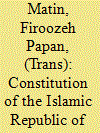

|
|
|
|
|
| Publication |
2014.
|
| Summary/Abstract |
On 3 December 1979, almost one year after Mohammad Reza Shah Pahlavi left Iran, the Constitution of the Islamic Republic of Iran replaced the monarchical constitution of 1906. The new constitution was to guarantee that the monarchy was abolished and the Islamic Republic system of government was enforced in its place. The constitution was to observe the Islamic and the nationalistic aims of the revolution with regard to the demands of a public that came from various social, religious, ethnic, and political backgrounds. Thus the 1979 constitution included differing components, which necessitated the amendments and the modifications that were added to the constitution in 1989. The constitution and its development are subjects that have been discussed in detail by scholars of modern Iran, among whom Asghar Schirazi stands out for his comprehensive study of the constitution. The following translation of the Constitution of the Islamic Republic of Iran highlights the relationship between the 1979 text of the constitution and the 1989 amendments in an attempt to contribute to the ongoing discussions on this subject.
|
|
|
|
|
|
|
|
|
|
|
|
|
|
|
|
| 2 |
ID:
127782
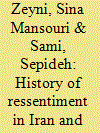

|
|
|
|
|
| Publication |
2014.
|
| Summary/Abstract |
Two dichotomies, one that resents the West and another that admires it, seem to have long polarized both Iranian intellectuals and the public imagination. Darioush Ashouri discusses this issue in terms of "ressentiment," a term he borrows from Nietzsche. This study puts Ashouri's scattered views within a Nietzschean framework to form a coherent theory, and places it against the background of a brief history of ressentiment in Iran. It then argues that signs of a ressentiment-less young generation, mostly university students, seem to be appearing, and a certain kind of social behavior on Facebook and a work by the Iranian musician Mohsen Namjoo are analyzed as evidence of this emerging mindset.
|
|
|
|
|
|
|
|
|
|
|
|
|
|
|
|
| 3 |
ID:
127784
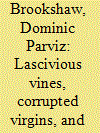

|
|
|
|
|
| Publication |
2014.
|
| Summary/Abstract |
The Persian wine production myth centers on the relationship between a male vintner and his female vine and her daughters, the grapes. This myth, the earliest extant examples of which are found in qas?das by the Samanid poets R?dak? and Bashsh?r Marghaz? and which was much developed by Man?chihr? and his contemporary Farrukh?, contains images of femininity, the mother-child bond, separation, violence, execution, and ultimate redemption. The grape harvest comes in the late summer and culminates in the Mihrag?n festival, a celebration focused on the grape and grape wine, at which poems containing versions of the wine production myth were recited. The present study maps the evolution of this myth over the span of a century through a close reading of eleven poems with specific reference to variations in narrative structure.
|
|
|
|
|
|
|
|
|
|
|
|
|
|
|
|
| 4 |
ID:
127780
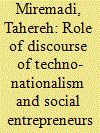

|
|
|
|
|
| Publication |
2014.
|
| Summary/Abstract |
This paper discusses the role of social entrepreneurship and the discourse of techno-nationalism in defining national selfhood in contemporary Iran. To examine the issue, this paper develops an in-depth case study of the development of stem cell research, and shows how an alliance between the leaders of the scientific community and Iran's politico-religious authority contributed to building technological capacity in the field of stem cell research in the first decade of the twenty-first century. The paper also highlights how the preliminary success of stem cell research, along with other knowledge-intensive technologies, has created a shared feeling of national pride and has served as the material base for the contemporary discourse of techno-nationalism. The paper concludes with the notion that the techno-nationalist discourse has the inherent potential to unwittingly help to redefine the dichotomy between Iran and the West in such a way that it becomes less antagonistic, should other factors permit.
|
|
|
|
|
|
|
|
|
|
|
|
|
|
|
|
| 5 |
ID:
127783
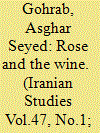

|
|
|
|
|
| Publication |
2014.
|
| Summary/Abstract |
As everyone knows, alcoholic drinks, including wine, are forbidden by Islam. Readers of Persian poetry often wonder how is it possible that Persian wine literature is one of the richest in the world and whether the poets and authors ever address the illicitness of the wine in their works. This article examines how one author, Zang? Bukh?r?, presents a catalogue of positive and negative qualities of wine in his Gul u mul ("The Rose and the Wine"). Through the genre of debate (mun?zara), he shows how a courtly audience may have tried to justify the drinking of wine. The article examines the formal generic characteristics of such debates, showing how the form of the debate is rather appropriate to let forbidden objects or ideas, in this case the wine, speak for themselves thus defending their position in an Islamic society. entertaining in is richness in metaphors and imagery used by the wine and the rose to voice their superiority to each other, but it also addresses a rather controversial topic in an uncontroversial style.
|
|
|
|
|
|
|
|
|
|
|
|
|
|
|
|
| 6 |
ID:
127781


|
|
|
|
|
| Publication |
2014.
|
| Summary/Abstract |
Perhaps inspired, more than anything else, by The Blind Owl's famous opening lines, the reception of the novel has so far been dominated by a dark view of the narrative. However, subtle inter-textual links and formal patterns in the narrative could help to read a radically subversive laughter in it which targets the novel's predecessors and readers equally and concurrently. This article engages the aesthetic qualities of the novel and attempts to account for and emphasize the literariness of the text in interpretation. By singling out a few inter-textual links and elaborating upon them in detail, the narrative's parodic laughter, its significance and the way it can change our appreciation of the novel are discussed.
|
|
|
|
|
|
|
|
|
|
|
|
|
|
|
|
|
|
|
|
|